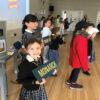
by Ellie Mckinsey
www.knowyourinstrument.com
If you recall your childhood years, you may remember that nearly any object – anything at all – can become a toy. A ruler or a rod can suddenly become an enchanted sword or a magic wand, a comb transforms into a guitar, a piece of paper when crumpled enough and tied with string becomes a puppet, even a pet. The possibilities are endless as a child learns to develop creativity and let their imagination soar.
Indeed, the best toys don’t even have to come from a store. A child may leave an expensive stacking toy in favor of crinkly paper, and that’s fine. Anything that sparks imagination, engages the senses and encourages social interaction can be considered a toy. Objects that let children explore new shapes, textures, sounds and colours are great for developing minds and bodies.
Here we’re taking a look at musical toys and what babies can get from playing with them. We’ll also share with you some tips on making your own musical toys for your babies to play with, using stuff you may already have at home. Let’s get started!
Importance of musical toys for your baby
In the first four months of a baby’s life, their emotional, sensory and motor experiences help prepare them for further developmental achievements. At this early stage, babies benefit from sensory toys that involve bright, contrasting colors, textures and pleasant sounds.
Moreover, by four months, babies can already bring their hands together in the middle of their bodies and use their eyes to co-ordinate hand movement. Musical, easy-to-grasp toys such as rattles help build grip and tactile stimulation while stimulating hearing.
By their sixth month, babies can now sit and hold objects with their hands. They start manipulating objects with more controlled movement patterns. At this phase, babies benefit from toys that roll or move and make sounds when touched. This further enhances gross motor skills and sense of hearing, and prepares babies for crawling (watching a baby crawl after a rolling egg shaker is super adorable).
Musical toys that encourage movement also give babies a sense of accomplishment and gratification that would inspire them to create the sounds again and again. It’s like they’re already making their own music! Soon, babies would develop a sense of rhythm, a more refined sense of hearing and more control over their movement.
This mix of motor control and sensory awareness is crucial for your baby’s overall development. The ability to fine-tune movements and notice differences in sounds is important for learning to communicate and later on, play an instrument such as a guitar, piano, viola or the drums.
Tips for making your own musical toys
So, are you ready to get crafty and make your own musical toys? Here are some fantastic ideas to get you started.
• Old or unused pots, pans, large tin cans and plastic bowls are great for beat-making and can be played with or without an object to hit them with (like a wooden spoon).
• Make your own rolling shaker or rattle using empty plastic water bottles. Put small raw pasta shells, marbles or pebbles inside and glue the cap shut.
• Give your baby a tactile and sensory feast by making scrunchy, noisy socks. Remember those socks that have lost their partners? They’re perfect for this project – simply put crinkly wrapping paper in them and close off the ends with a secure and tidy knot. Let your baby scrunch the socks with delight.
• Got an empty tissue box and extra elastic bands lying around? Fashion a string instrument with them!
When making your DIY musical toys, remember to watch out for any potential hazards like small parts, sharp corners or edges, loose strings and toxic materials. Make sure the materials you use are clean and baby-safe. Give your toys a test run before letting your child play with them, and always keep an eye on your baby during playtime. Have fun! –










